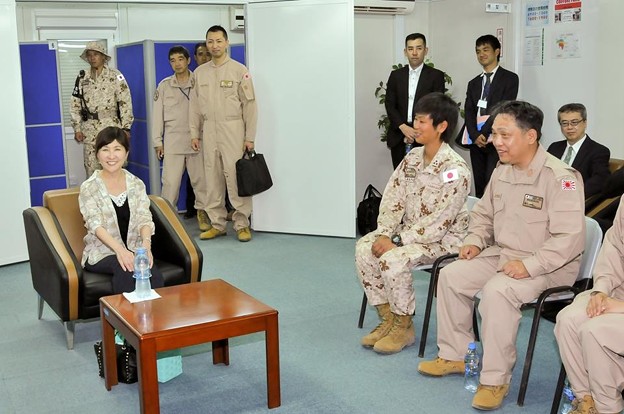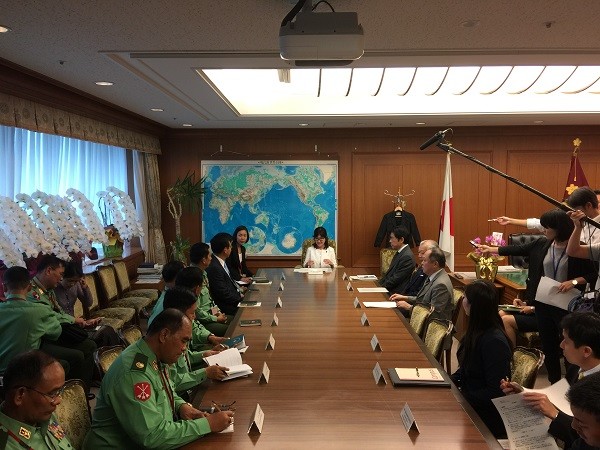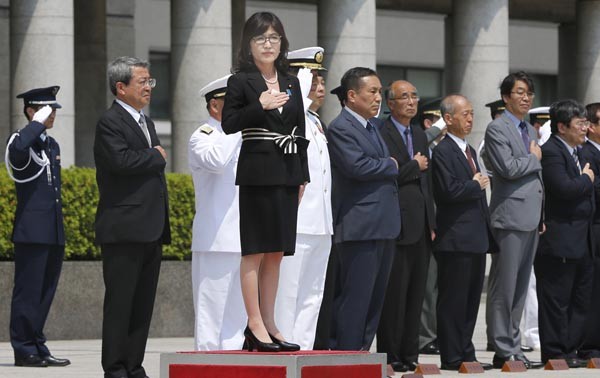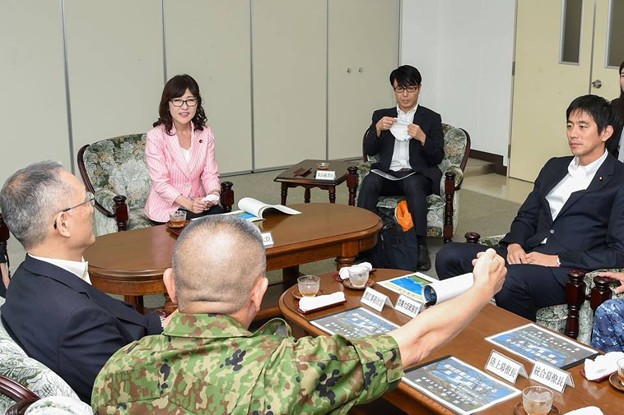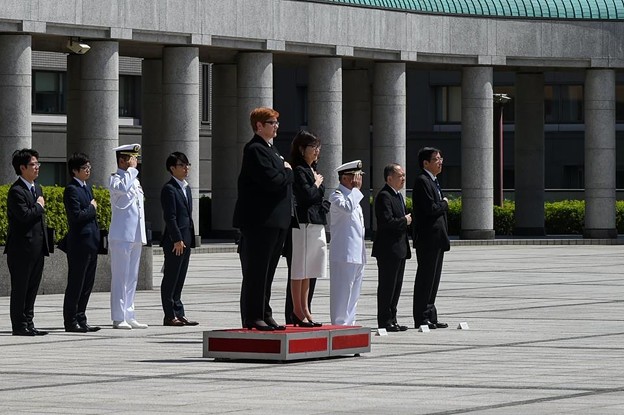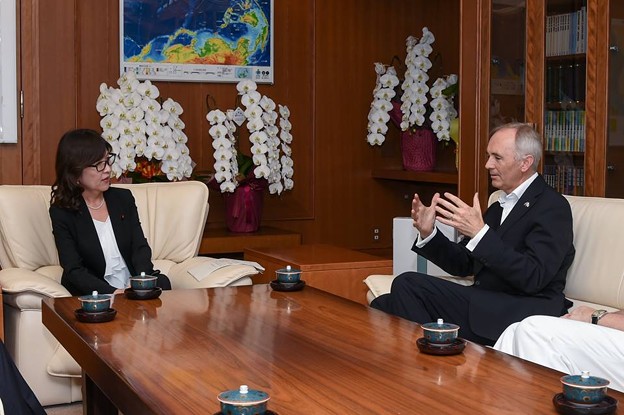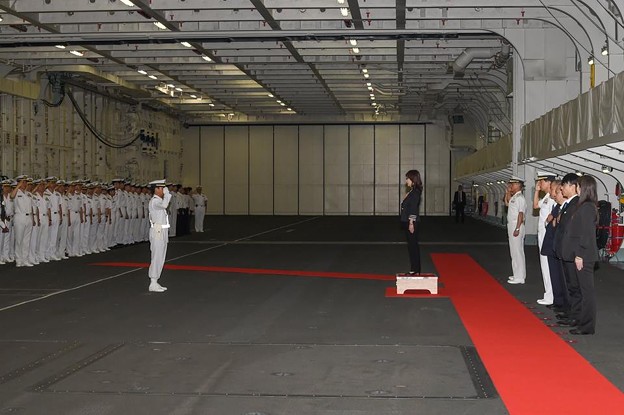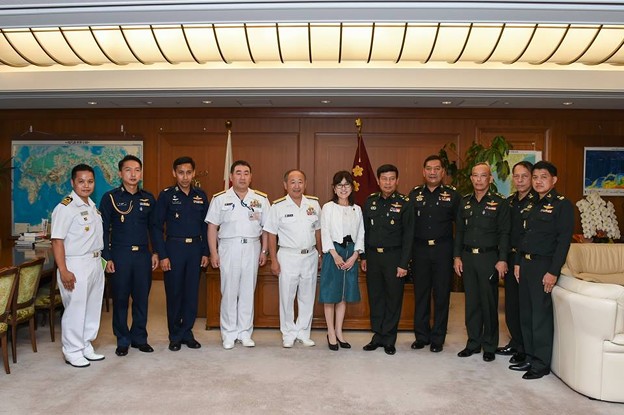Pentagon Studied Future Japan Nuclear Arsenal and War With China
Net Assessment think tank under scrutiny for obscure research
BY: Bill Gertz
October 7, 2016 4:59 am
Japan can quickly build a strategic arsenal of land-based and submarine-launched missiles capable of killing up to 30 million Chinese in a nuclear war, according to a Pentagon sponsored study.
A report produced for the Pentagon’s Office of Net Assessment reveals Japan’s government could arm itself with nuclear weapons within a 10-year period, based on Tokyo’s advanced nuclear power infrastructure and its present day space launchers, cruise missiles, and submarines.
Casualty estimates in the report outlining a Chinese nuclear attack on Japan indicate Tokyo would be no match in a future nuclear exchange. Japan would suffer up to 34 million deaths—27 percent of the island nation’s population—from Chinese nuclear missile strikes.
Nuclear experts were unable to calculate accurately Japanese deaths from a nuclear war because of a disagreement among analysts on whether large blasts against cities would create firestorms and thus likely double the death rate. According to one briefing slide in the report, “Either way, Japan faces extinction” from a Chinese attack.
Disclosure of the report comes amid growing tensions between Tokyo and Beijing over maritime disputes involving Japan’s Senkaku Islands, which lie in the East China Sea. China claims the islands as its own territory. Japanese and Chinese military forces have been engaged in cat-and-mouse naval and air activities near the islands for the past several years.
The study is a clear sign of concerns within the U.S. government that the Obama administration’s anti-nuclear policies have increased the danger of nuclear arms proliferation, as American non-nuclear allies consider developing their own nuclear arsenals.
Japan has been building up its small military forces in recent years and has reinterpreted parts of the officially pacifist constitution to permit a wider range of military activities. In Havana Thursday, visiting Japanese Prime Minister Shinzo Abe met with former Cuban leader Fidel Castro who agreed to seek a world free of nuclear arms. In April, Abe administration officials told the parliament that the Japanese constitution does not prohibit possessing nuclear arms.
The United States currently uses its nuclear missiles, submarines, and bombers for extended deterrence in providing security to states like Japan and South Korea. U.S. nuclear forces are aging and in need of modernization. By contrast, Russia and China are aggressively modernizing their nuclear forces and North Korea also is building up nuclear forces and delivery systems. Under the Obama administration’s nuclear deal with Iran, Tehran will be able to develop nuclear arms after 10 years.
According to the ONA report, the Pentagon’s interest in Japan’s nuclear options has taken on urgency because Japanese fears that current U.S. nuclear security guarantees against Chinese or North Korean nuclear attacks are weakening and could be insufficient in the future to deter Beijing or Pyongyang.
According to the report, factors that could drive Japan to nuclearize include a major shift in U.S. deterrence policy, South Korean building nuclear arms, an Iranian nuclear test, or the use of nuclear arms by Russia or China.
The findings were part of a workshop, “Nuclear operations and implications,” held in Washington on June 10, which included American defense and nuclear officials assessing how Japan would deploy and use nuclear missiles built from current space launchers and submarines.
The workshop and subsequent report were organized by the defense contractor Long Range Strategy Group, a consulting group. The group’s president is Jacqueline Newmyer Deal, a friend of Chelsea Clinton, vice chair of the Clinton Foundation.
According to private emails made public recently, Hillary Clinton sought to assist Deal in gaining consulting contracts with the State Department policy planning office and the Pentagon undersecretary of defense for policy seven years ago while she was secretary of state.
The workshop was paid for by the Pentagon’s Office of Net Assessment, a government think tank that has come under fire in recent months for controversial research that critics say appears to have little utility for military planning or defense policymaking.
A senior military official said ONA’s director, James Baker, who took over the office last year, is working to fix the perception within the Pentagon that the Office of Net Assessment is not producing relevant studies and is focused too much on contractor work.
A defense official who defended the office said ONA is charged with engaging in unconventional thinking and research on national security issues.
In addition to the Japan nuclear war study, other ONA contractors have produced studies that critics say lack relevance or have questionable value.
According to Pentagon documents obtained by the Washington Free Beacon, among some of the more controversial ONA studies are:
A report by the Long Term Strategy Group on Americans as a “warlike” people descended from a dominant and belligerent Scotch-Irish culture. The report cost more than $60,000 to produce.
A two-year study of Russian and Chinese leaders’ facial and body movements called “movement pattern analysis” that sought to develop a capability to decode foreign leaders’ decision-making from their movements. The study cost between $300,000 and $800,000.
A report by a global warming advocate on “Reconsidering Resources,” which examined how resources and population are declining and technology is increasing. The study cost more than $184,000.
A report on Chinese movies, “A Neo-Letesian, Psycho-Cultural Analysis of Chinese Movies,” sought to understand Chinese culture through propaganda films.
Two studies on anti-war intellectuals, “War and the Intellectuals: Trends in American Elite Attitudes Toward War,” and an accompanying workshop report, assert that the divide between cosmopolitan American elites and less-educated patriotic Americans could lead to civil violence in the future. The workshop and report cost around $100,000.
The focus on contractor studies and a shortage of formal strategic military assessments by the office prompted Gen. Joseph Dunford, chairman of the Joint Chiefs of Staff, to re-establish a separate net assessment capability within the Joint Staff, according to military officials. Dunford is reviving the Joint Military Net Assessment group as part of the effort.
Dunford earlier this year produced a top-secret report known as the Chairman’s Risk Assessment that identified five “challenges” to the United States. The report discussed Russia, China, Iran, North Korea and the Islamic State terror group. Dunford, in congressional testimony in February, outlined the secret assessment, noting that military threats involve adversaries’ use of non-traditional military means, such as cyber attacks or covert information warfare operations. Examples cited include operations by Russia in taking over Ukraine’s Crimean peninsula, and China’s ongoing covert efforts to seize control of the South China Sea.
Dunford’s report also identified major sources of U.S. military risk. Chief among the risks is the danger of U.S. forces having to fight more than one conflict at a time. Other key vulnerabilities for the military include shortages of intelligence resources, missile defenses, naval expeditionary forces, airborne command and control, air superiority forces, global precision strike weapons, and cyber warfare forces.
A military official said Dunford reestablished the Joint Staff net assessment to better help him provide military advice to the president and defense secretary.
The secretive Office of Net Assessment is tasked with producing strategic assessments of military balances between the United States and foreign states, as well as other threats like the Islamic State. But in its more than 40 years, ONA has become more of a defense consultancy, doling out between $10 million and $20 million a year to contractors, while producing few of the secret net assessments.
Under its long-time director Andrew Marshall, however, ONA played a key role over the past decade in highlighting the growing threat posed by China. ONA studies on China corrected the widespread misperception among both military and defense officials that the Asian country was a benign power. Marshall retired last year.
Formal net assessments are several hundred pages in length and differ from intelligence estimates by contrasting U.S. capabilities and weaknesses against other threats. The emphasis on U.S. vulnerabilities is one reason net assessments were not made public. Doing so would assist foreign powers in developing forces and capabilities for defeating the United States in a future war.
Net Assessment defended the Japan nuclear study as well as other contracting work in a statement to the Washington Free Beacon.
“ONA is also charged with considering ‘uncomfortable questions’ that sometimes challenge U.S. policy preferences,” the statement said. “Recent research work includes everything from the implications of an expanded nuclear club of nations to the future of the international order to the impact of demographic shifts on Chinese military capacity.”
The office’s research agenda is “robust and innovative,” and supports senior defense leaders with comparative analyses on military, technological, and other topics “affecting the future capability of the U.S. and other nations, with the goal of identifying emerging problems and opportunities that deserve the attention of senior defense officials,” the statement added.
Other missions include war gaming, net assessments, studying the future security landscape, and pursuing emerging research topics, methods, and sources.
Regarding contracts, ONA follows federal acquisition regulations that involve both internal ONA review as well as the Pentagon’s acquisition directorate.
ONA staff and military officers also evaluate contracts based on whether they contribute to the office’s mission and whether the contractor can do the work. The office has used 90 contractors over the past decade.
The Japan nuclear report, while unclassified, appears to provide an expert assessment for how Japan could best develop nuclear forces, taking into account the Pacific nation’s World War Two experience of conventional firebombing and two nuclear attacks.
As a result of that experience, the report found that Japanese naval forces would likely choose a nuclear force built around off-shore based, nuclear-missile firing submarines, with a land-based component of road-mobile missiles.
Japan’s current space launcher, the Epsilon, is similar to the ten-warhead capable U.S. MX missile, systems which were dismantled in 2005.
A Japanese nuclear missile may not need multiple warheads, but Tokyo could develop the capability as China continues to pursue missile defense developments.
Regarding warheads, Japan could build a warhead similar to the U.S. 1.2 megaton W-47 warhead.
The attendees at the Japan nuclear forces conference were told that Japan likely would adopt a “deterrence by punishment” policy—threatening proportionate nuclear strikes if attacked—rather than deterrence by denial—dissuading nuclear strikes by hardening or hiding targets.
The report discussed a briefing at the June conference that provided detailed casualty estimates for a nuclear war between China and Japan.
In a nuclear exchange with the Chinese, Beijing would likely strike the 20 to 30 largest Japanese cities with 3 megaton weapons—the equivalent of 3 million tons of TNT—killing between 23 million and 33 million people.
A nuclear-armed Japan could launch ballistic and cruise missiles in several retaliatory scenarios, including 150 kiloton bombings of 45 cities, killing 20 million Chinese, or the use of larger 1.2 megaton warheads on 60 cities, for an estimated toll of between 96 million and 128 million people.
For North Korea, an attack on 10 Japanese cities with 10 kiloton warheads would kill around 1 million, and could invite a Japanese 1.2 megaton blast over the North Korean capital of Pyongyang, killing an estimated 1.1 million North Koreans.
The officials assessed Japan could easily developed torpedo-tube launched land attack cruise missiles with a range of 1,500 miles. Japan plans to have 22 submarines in its naval forces and could keep 100 nuclear cruise missiles on station.
A second option would be for Japan to develop intermediate range missiles with 2,000-mile ranges that could be capable of hitting all major Chinese cities from Japanese territory.
Japanese space officials have indicated that current space launchers can be fired from mobile launchers—an indication that the systems could be converted from launching satellites to carrying warheads.
http://freebeacon.com/national-security ... war-china/









